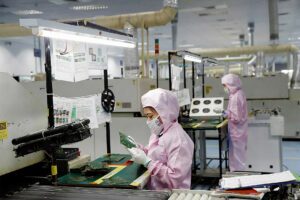Manufacturing output up 5 months in a row

Factory output rose for the fifth consecutive month as economic activity gradually picks up, data from the Philippine Statistics Authority (PSA) showed.
Preliminary results of the latest Monthly Integrated Survey of Selected Industries (MISSI) reported the factory output as measured by the volume of production index (VoPI) grew by 3.5% annually in August, faster than the 2.4% in July but slower than the 533.7% in August 2021.
August registered the highest VoPI growth in five months or since March’s 345.9%.
“The August figure increased slowly but surely. Although there was a comparison between August last year versus this year, and there was a big difference. But only because last year’s base was compared with August of 2020 when lockdowns were abundant and the coronavirus disease 2019 (COVID-19) was starting,” Philippine Chamber of Commerce and Industry Honorary Chairman Sergio R. Ortiz-Luiz, Jr., said in a phone interview.
Last year, Metro Manila and other provinces were placed under the Enhanced Community Quarantine (ECQ) lockdown — the strictest form of lockdown — from Aug. 6 to 20. This later eased to a Modified ECQ where granular lockdowns were implemented.
Year to date, factory output averaged 21.0% in the January to August period.
In the report, the PSA said that the August figure was mainly driven by annual growth seen in 17 out of 22 industry divisions.
VoPI recorded positive annual growth in manufacture of machinery and equipment except electrical (78.0% from 32.3% in July), fabricated metal products, except machinery and equipment (30.4% from 25.8%), transport equipment (24.6% from 16.7%), leather and related products, including footwear (22.2% from 18.4%), other manufacturing and repair and installation of machinery and equipment (22.7% from 8.2%), paper and paper products (17.9% from 17.6%), and chemical and chemical products (12.5% from 4.6%).
However, five industry divisions reported declines, led by manufacture of electrical equipment (-49.3% from -51.7%), basic metals (-24.7% from -20.4%), and tobacco products (-15.2% from -18.9%).
“For some manufacturers, the peso depreciation, inflation, and global supply chain constraints have some effect on manufacturing. Because if you’re a manufacturer of goods that’s substituting for imported goods, it’s going to be very expensive. It probably had an effect on electronics, garments and other goods that need imported materials. But this should be countered by the export of their goods,” Mr. Ortiz-Luiz said.
To compare, S&P Philippines Manufacturing Purchasing Managers’ Index (PMI) expanded to 51.2 in August, bouncing back from the six-month low of 50.8 in July. A PMI reading of above 50 means improvement in operating conditions compared with the previous month, while a reading below 50 shows deterioration.
In a separate phone interview, Federation of Philippine Industries (FPI) Chairman Jesus L. Arranza said a slow growth could have also been affected by the depreciation of the peso.
“These companies are also exporting. And if it’s mostly local production, it has advantage for export. And with the US Dollar-Peso rate, others will buy more goods from the Philippines,” he said.
Capacity utilization in manufacturing averaged 71.4% in August, slightly higher than July’s 71.3% but higher than the 65.8% recorded in August 2021. Of the 22 product categories, 20 reported utilization rates of at least 60%.
“I think there will be more manufacturing activity in the coming months. People shouldn’t see the peso depreciation as a ‘prophet of doom.’ But I think people will learn how to be frugal in terms of movement and costs — everyone will be cost conscious” Mr. Arranza said.
Mr. Ortiz-Luiz warned that the manufacturing industry should be cautious of their supply chain in the coming months.
“For example, microchips are exported but we also import them. Car producers, also, cannot deliver because there was a lack of microchips due to supply-chain constraint caused by the Russia-Ukraine war. This caused sanctions. Some of the countries supplying to us are sanctioned, therefore they couldn’t export to us — like fuel,” he added. — Ana Olivia A. Tirona




